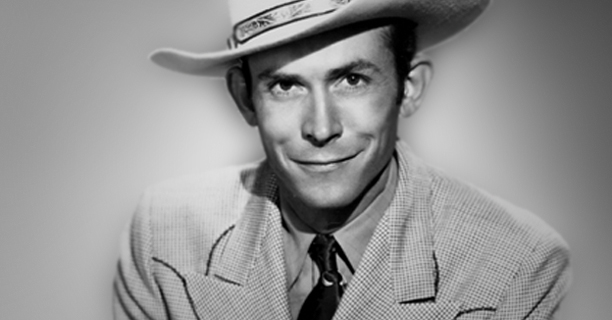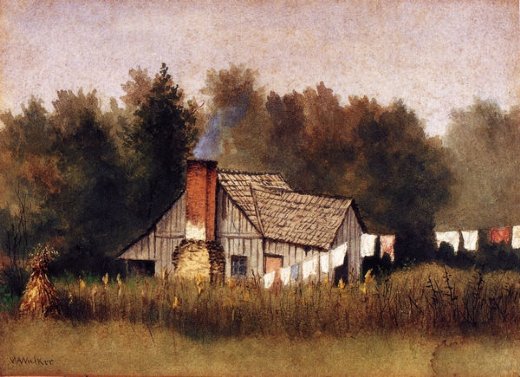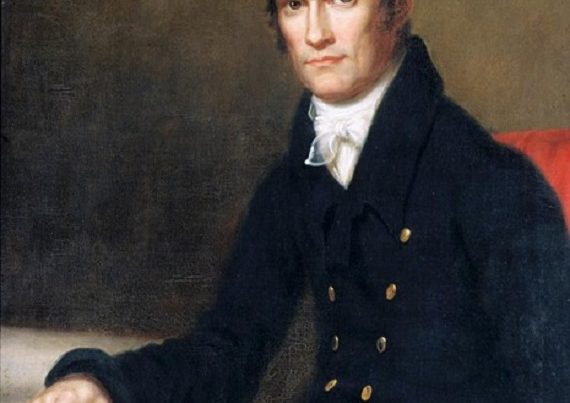
This is the second installment of the series ‘What Makes this Musician Great,” and will focus on the man from Butler County, Alabama – Hank Williams. In this ongoing series, I explain what makes Southern musicians and their music so great and worth remembering while using non-technical language that can hopefully be understood by non-musicians, and this is the perfect format for an artist like Hank.
I’ve noticed that a lot of people get Hank’s timeline wrong in their heads, and they generally think of him as being a later phenomenon of the mid- to late-50’s instead of the late-40’s and early-50’s. He signed with MGM Records in 1947, appeared on the Grand Ole Opry for the first time in 1949, and died on New Year’s Day 1953 at the incredibly young age of 29. His superlative talent is divided into Hank the Songwriter and Hank the Performer. While either of those gifts would have been enough alone to put him on the map, Hank made abundant use of both to rocket him into legendary, once-in-forever status. Therefore, in explaining what makes Hank Williams, I must start with his exclusively iconic way of telling his own stories in a way that completely draws you in.
Music has a unique ability to transport the listener directly into the heart, soul, and mental state of the musician. Not only do you know what they know, you can also feel what they feel, if it’s done effectively. Even if a totally disconnected musician gave a dry, rote rendition of a Hank Williams song, it would still be compelling – that’s how good the songs were. But to have the experience of hearing Hank himself sing them is transcendental. You fall helplessly and completely into his world, and the most inconceivable things in your own world suddenly make perfect sense in his. You deeply understand what it means to be so lonesome you could cry. You get it. And you can’t ever forget it.
Many recording artists are not songwriters – they record songs written by someone else. Therefore, since Hank Williams was known for his own original songs, could he read music? Simply put, no. He could not read any notes on the staff, and certainly couldn’t write them down. His original manuscripts of his own composed songs were simply lyric sheets, and he kept all the melodies in his head. Although he knew which chords to play on the guitar with each song, he didn’t add them to the lyric sheets, either. Typically, a songwriter adds chord symbols above the lyrics as a reminder of which chords to play and where to play them in relation to the lyrics, but Hank’s pages contain lyrics only – no chord symbols. In the piece on Duane Allman, I mentioned how Duane also couldn’t read sheet music, but could read the hybrid music theory notation called the Nashville Number System used in recording studios. However, since Hank died long before the Nashville Number System was created, there’s certainly no chance he could read and write it.
Secondly, was Hank Williams a virtuoso guitarist? Could he shred? I actually laughed out loud while writing those two lines. Although Hank was a superb songwriter and performer, he was DEFINITELY NOT a guitar legend. And to clarify, “to shred” is a figurative reference to a guitarist’s ability to play so fast and furiously that the strings might break. That wasn’t Hank by a long shot. In fact, I’ve never met anyone who claims to play the “Hank Williams style” of guitar, because there’s not one. I have seen a couple of YouTube videos that promise to teach the viewer how to play the “Hank Williams style,” but none of them really do, because it doesn’t exist. Hank did not play guitar solos at all, and his strumming and picking style was a generic blend of Folk guitar, Gospel, and the Blues. It’s the same style that pretty much everybody plays, and that’s perfectly suited for his music. Although I can name a lot of guitarists who play Bluegrass in the style of Lester Flatt or Doc Watson, or Appalachian and Folk music in the style of Maybelle Carter, I can’t really think of any iconic, defining style of Country guitar. With the exception of some notable “shredders” like Jerry Reed, Chet Atkins, and Roy Clark, most Country guitar players use a simple, basic, universal strumming and picking style that simply gets them from one song to the next. That’s all they need, because the magic of the music is not in their guitar virtuosity, but in the lyrics and the voice.
That being said, Hank could definitely play and sing the Blues. He was taught guitar by a black man named Rufus Payne who played in a local string band, and he taught Hank how to play both the Blues and Hillbilly music. In fact, one of Hank’s earliest hit songs, “My Bucket’s Got a Hole In It,” is a classic 12-bar Blues song. However, in all of Hank’s songs, you can easily hear the voice of a Blues singer. It doesn’t matter if it’s the hip-wiggling hits or the tear-jerking ballads, Hank’s voice is always plaintive and powerful. Since he started out singing without microphones and amplification, his voice carries a projected resonance that is perfect for reaching out to the listener and telling a story, and this was part of his iconic magic. When Hank told a story, it felt like he was telling it directly to you, and he was able to animate the lyrics with his voice to give them a fresh delivery. As a performing musician, I have to admit there have been many, many times that my mind drifted off in the middle of a song, and the whole performance became kind of auto-pilot. You never, ever get that feeling from Hank Williams. It always feels like he’s looking right at you and singing right to you.
Thirdly, was Hank Williams a religious man? That’s a tricky question to answer, and perhaps can best be addressed by simply saying that Hank was “a Southern man.” Of course, like almost everybody in Butler County, Alabama, Hank was raised as a primitive Baptist, and his mother had a profound influence on his love and understanding of Southern Gospel music. He grew up singing Sacred Harp music in the Mount Olive Baptist Church in Georgiana, Alabama. While his adult lifestyle usually reflected the exact opposite of a strict Baptist upbringing, his music was deeply spiritual at times, and I think this is an important key to understanding his greatness. Many of his songs openly portray a conflicted man disturbed by a deep questioning of his faith while fielding assaults from a dangerously difficult world, and the genius of Hank Williams was his gift for musically speaking that conflict in a way to which all of us could relate. Hank actually created an alternate personality called “Luke the Drifter” which allowed him to record and perform deeply emotional songs that were basically spoken-word sermons without encroaching on his pop star persona.
On a side note, I often think about the struggle with inner demons as reflected in the music of someone like Hank Williams, and our modern, 21st century perspective on mental illness and addiction. Like so many artists before him, Hank’s music was directly inspired by and fueled by his own personal pain and suffering – conditions that could be effectively treated today by therapy and medication. Therefore, I often wonder what would have happened to a lot of the 20th century music that shaped our lives if the artists had been able to get the help they needed and deserved. Is it unreasonable or even cruel to think that sometimes society needs artists to suffer and struggle in order to lift our own spirits with their brilliance? I’m not at all suggesting we do away with therapy and medication, because there are some people walking around out there who need some serious help. I’m just wondering, that’s all. Just thinking.
I will focus on three specific songs recorded by Hank, and narrow my focus to the songwriting genius, inner spiritual struggle, and performance magnetism that I believe will help explain Hank Williams to anyone. These songs will help you understand how Hank Williams could tear your heart out.
“Hey, Good Lookin’” (1951)
One of the defining features of Country music and Country music stars is the strong, vital connection to the audience. Country music NEEDS an audience, because the performer is trying to communicate something to somebody. Hank Williams definitely feeds off of the audience energy at the Grand Ole Opry in this video, and gives them what they came to see. This is why Country music features vocals, and rarely features an instrumental arrangement, because the performer needs to grab the listener with a story and not let go. Hank even wiggles his hips a little bit as soon as the song starts, which makes the girls (especially the teenage June Carter next to him) squeal in delight. “Hey, Good Lookin’” is not poetry – it’s a hit song, and Hank wrote it that way for himself to perform. The form is a simple AABA song form, which was popular for pop and jazz standards throughout the 1940’s, but kind of disappeared in the Rock ‘n Roll era and the verse-refrain-bridge format. The first “Hey good lookin’” part (A) matches the follow-up “Hey sweet baby” part (A). That is followed by the “hot rod Ford and a two-dollar bill” part, which is different (B), and is completed by a return to the “Hey good lookin’” part (A). Altogether, that creates the AABA form I mentioned. Then, there’s a pedal steel break, and then a whole new set of lyrics arrive in the same AABA form. I’m not going to call this a genius song, but it’s a darned good one. Hank sets up a catchy rhyming pattern within each A section (lookin’ rhymes with cookin’) and he adheres to it strictly throughout the composition, and the whole song uses double-meanings for someone looking so hot that she’s “cooking.”
The real genius of the song is the magnetic performance delivered by Hank right into the TV camera. His performance, however, might have been just a little bit “under the influence.” Anyone who has ever taken a tour of the old Ryman Auditorium in Nashville where the Opry originated knows that right out the back door there are honky tonks and bars up and down the street. Therefore, it was kind of common for performers to temporarily “go missing” when it was their time to perform. Hank went “missing” a lot, and his constant state of inebriation eventually caused the Grand Ole Opry to fire him in 1952.
“I’m So Lonesome I Could Cry” (1949)
This song is breath-taking to me in the minimalist way it conveys the worst pain of heartbreaking loss. Personally, it is the single most painful song I’ve ever heard, and yet I cannot stop listening. Most Country songs that try and convey the pain of loss unfortunately miss the mark where this one connects so perfectly with the listener – every mundane thing that Hank sees and hears reminds him of his pain, and that’s what we all can relate to. Even things that shouldn’t be painful become painful in his condition, and we’ve all been there. The lyrics are raw, intense, gloomy, and blunt. Everything hurts, but I simply cannot stop listening. The title of the song is the refrain, and each verse (except for the 2nd verse) concludes with “I’m so lonesome I could cry.” The pedal steel guitar is used very effectively to simulate a weeping sound effect, and Hank adds a touch of a yodel to his voice to perfectly mimic the pedal steel and the weeping. This song is the perfect example of what I described earlier as Hank’s stunning gift of telling a story and pulling you straight into his head and heart. With a song like this, you don’t just know what Hank feels – you FEEL what he feels, and you cannot stop listening.
The song is in triple meter, which is indicative of a slow waltz, and it is surprisingly in a major key instead of minor. Although many lesser songwriters would be tempted to emphasize the pain in the lyrics by placing the song in a minor key, Hank gives it a semi-Blues structure, which keeps it in a major key. The chords are exactly the same as any 12-bar Blues song, but it stretches out into 16 bars for each section instead of the usual 12 bars. This is one of the hidden aspects of genius for this song – Hank emphasized the sorrow and pain by giving it a Blues feel without making it a Blues song, and without falling into the usual predictable choice of a minor key for sadness.
“I Saw the Light” (1948)
There is an official studio version of this song recorded by Hank Williams, and it features his solo voice and light backing instrumentation. However, the whole time you’re listening, you can’t help but wish there were more voices, because this song is a good old-fashioned revival Gospel tune, hallelujah! That’s why the video link I chose is the full cast version from the same Grand Ole Opry broadcast as “Hey Good Lookin.’” Roy Acuff had enough sense to know that this song deserved the full treatment, and after introducing it as a “camp meeting song,” he even took the first verse for himself. I know people who like to point to this specific song as an indictment of religion as a whole, because they believe it outlines an iconic lie – the very guy singing about holy redemption and salvation was one of the most aggressive sinners in the business. I can’t argue with that. However, I believe Hank’s personal failings only reinforce the powerful promise in this simple tune. If Hank can be saved, ANYBODY can be saved, and there is no limit to the offer. Nobody was more aware of the demons haunting Hank Williams than Hank Williams, and yet this song is still so full of hope and joy, as it should be.
The song construction of “I Saw the Light” is very similar to the Woody Guthrie anthem “This Land Is Your Land.” It begins with the refrain and ends with the refrain, and the refrain is repeated between each verse. The last line of each verse is the song’s title, which takes it right back into the aforementioned titular refrain. There is no mistaking the inspirational message of this composition, as the words “I saw the light,” are all over the place, and it’s easy to follow Hank’s intention for those words to be belted out louder than all the others. Whenever I hear this song performed with a throng of energetic voices, I can easily picture the singers arranged in a Sacred Harp square inside a hot Alabama primitive church – young and old, men and women, blacks and whites, preachers and sinners – all rejoicing with the promise of an everlasting life.
What are your favorite Hank Williams songs? As you listen to them, try to find that easy strumming country guitar, that plaintive Blues voice with yodel breaks that mimic the pedal steel, and that strong evangelical Southern spirituality always pushing to break through, grab you, and tell you a story.









Thanks for the honest look at the reality of life as experienced in the deep South after the depression for the poor and rural.
Black or white, none of had money, bur we had each other, we had God and we always had music.
Hank Williams spoke to us in our words and wrote and sang in ways that we could identify with.
I have always maintained that Hank recorded the first Rock-A-Billy and song with “Fool About You.”
The rhythm and the timing and the chord progressions of “Fool About You” foretold Bill Haley and the Sun Records days.
Feel free to discuss the matter or my thoughts.
Great article Tom. Lost Highway and Your Cheating Heart can wreck ya pretty good, whereas, Jambalaya pulls you right into the party and you do not want to go home. Long live Hank.
An exceptionally insightful article. I read it after attending a concert by an interesting new country artist, Parker McCollum, and wondering on the way home what makes an artist great and lasting, whether it be Hank Williams or the Beatles. I googled “what makes Hank Williams great” and this came up. The article delivers on that question and does so thoughtfully and comprehensively. Thanks.
ive been singing hank williams songs since i was about 12 years old i think i can sound like him on some of his songs